Runes are stat-boosting effects that are chosen before the match starts. You can either choose the presets available or customize them based on your playstyle and your matchup.
Understanding Runes are an important part of learning Wild Rift. One reason for this is because a certain set of Rune works well with a certain playstyle, so you might be playing inefficiently with Runes that are not meant for it. As a result, it will hinder your output and progression through the ranks.
The right Rune combination can theoretically determine who would win when you are facing an enemy equally as skilled as you are.
This guide aims to make you, our dear reader, understand the Keystone & Minor runes so you can select the best Runes and Rune combinations that are perfect for your playstyle.
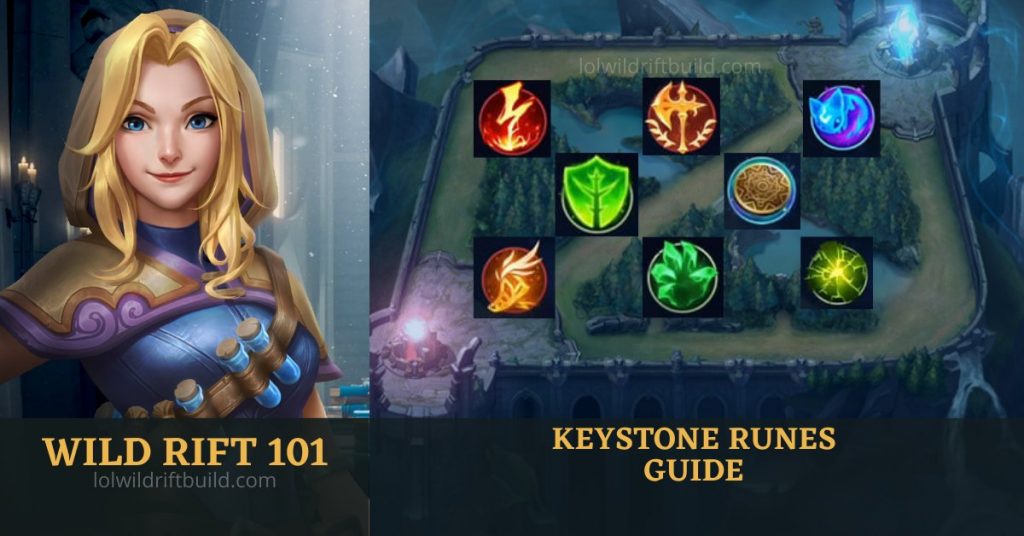
Rune Types
Let’s first take an overview on all types of runes.
Keystone Runes
Keystone Runes are the major runes with significant offensive or defensive effects. Because of its considerable impact to one’s gameplay, choosing the right Keystone Rune for their champion is a crucial part of the game.
Electrocute
Aery
Conqueror
Fleet Footwork
Grasp of the Undying
Aftershock
Font of Life
Phase Rush
Domination Runes
Domination Runes are minor runes which are offensive in nature. It provides small offensive bonuses which are not as significant as Keystone Runes but could possibly impact the game significantly as well. In terms of minor runes, domination runes are arguably the most important.
Brutal
Gathering Storm
Hunter – Vampirism
Triumph
Weakness
Champion
Resolve Runes
Resolve Runes are minor runes which are defensive in nature. It provides small defensive bonuses which grants either health, different kinds of resistances, or regeneration.
Adaptive Carapace
Conditioning
Hunter – Titan
Second Wind
Loyalty
Backbone
Inspiration Runes
Inspiration runes are minor runes that grants a variety of utility stats such as movement speed bonus, ability haste, mana, or damage to Epic monsters and turrets, and bonus gold.
Pathfinder
Mastermind
Hunter – Genius
Sweet Tooth
Pack Hunter
Manaflow Band
Above are the type of runes in Wild Rift. Now, lets go deep into all the Runes.
Rune Guides
Keystone Runes
Electrocute

Electrocute is the Keystone Rune for burst damage champions. It makes you deal bonus adaptive damage when you hit an enemy with three separate attacks or abilities within three seconds. Adaptive damage means that it deals physical or magical damage depending on which stat of yours is higher.
Another important thing to note is that you have to hit the enemy with separate attacks or abilities. For example, if you use Garen’s E(3), Judgment, it will only count as one stack even if you hit the enemy multiple times. It’s the same for (almost) all abilities such as Ahri’s W(2), Fox-Fire or Wukong’s R(4), Cyclone. I said it’s “almost” because it has an exception which is Zed. The duplicate abilities from his shadows counts separately so its possible to activate Electrocute with him without auto attacking or using his ultimate.
Pros
- Reliable source of bonus damage to increase your burst damage in combos
- Strong early game impact which helps on trading and establishing lane control especially for mid laners.
Cons
- 25 second cooldown which is not affected by ability haste. Proccing this rune twice in a clash is rare.
- Loses to Conqueror in drawn out fights.
Example of champions that uses Electrocute:
- Zed
- Lee Sin
- Evelynn
- Wukong
- Gragas
- Ahri
- Akali
- Fizz
- Olaf
- Shyvana
Conqueror

Conqueror is the Keystone Rune for champions with strong DPS (damage per second) output, particularly bruisers (Fighters) and ADCs (Attack Damage Carry or Marksman). It grants bonus adaptive damage every time you hit the enemy with separate attacks or abilities. After gaining the maximum five stacks, it grants 10% bonus damage (7% on ranged champions) on top of all your damage output. The bonus AD or AP stacks together with the adaptive bonus damage because it registered as a separate instance of damage.
Conqueror’s stack counter works exactly like Electrocute except that when you have the maximum stacks, the buff refreshes its duration every time you damage the enemy with a new attack or ability.
Pros
- Conqueror has no cooldown. Its effect is useful all throughout a fight.
- Increases your damage over time. The longer the fight drags on, the stronger you become.
Cons
- Underwhelming in the laning phase and in the early game because fights are never long enough to activate the full benefits of Conqueror yet.
- Loses out to Electrocute in short burst trades.
Example of champions that uses Conqueror:
- Wukong
- Darius
- Zed
- Olaf
- Ezreal
- Xin Zhao
- Shyvana
- Jax
- Yasuo
- Graves
- Garen
- Camille
Electrocute Vs. Conqueror
I did a short test with Garen and Zed to compare the damage output for both champions. I used Garen for the auto attack test because he is a champion without any auto attack modifiers so it will be easier to judge the effects of the Runes alone. I used Zed for the full combo test because he is a champion who can potentially use both Runes effectively.
Garen – Auto Attack Test
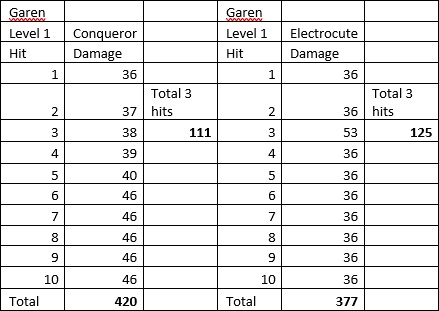
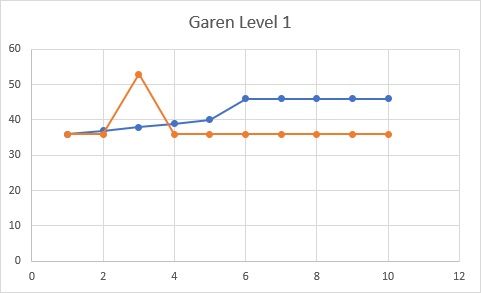

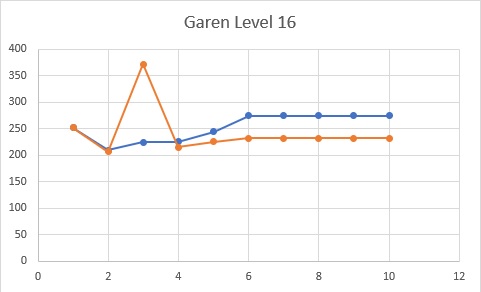
It’s obvious from the data that Electrocute (the orange line) is superior on the short run or through burst damage, but its performance drops after its effect procs and Conqueror (the blue line) shine after and produces consistently higher damage afterwards.

This graph shows that after 8 attacks, Conqueror starts to outperform Electrocute in terms of total damage output.
Zed – Burst Damage Test
Zed’s full burst damage combo, W+R+Q+E+AA deals at least 8 instances of damage in quick succession so it’s not clear as to which Rune deals more damage at first glance. Most people use Electrocute on him and it is clear that Electrocute is more helpful in the early game. Yet, Conqueror is the recommended rune on his Bruiser build plus I had a friend who was a Challenger on League of Legends PC use Conqueror on him and succeed consistently. So, what gives?
I tried the combo in three different scenarios. First, with Electrocute:
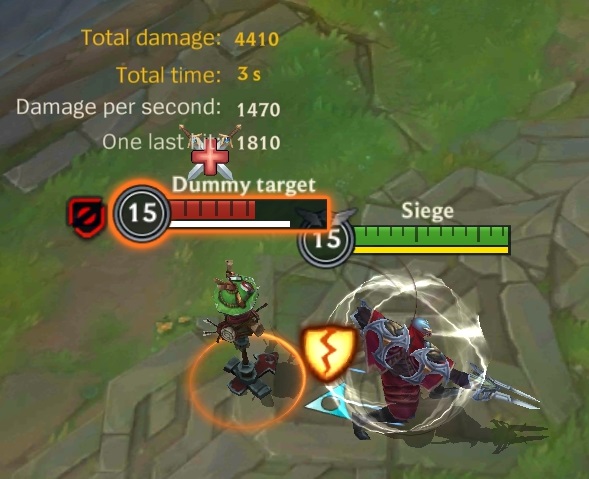
It dealt a total of 4,410 damage.
Second, with the Conqueror:
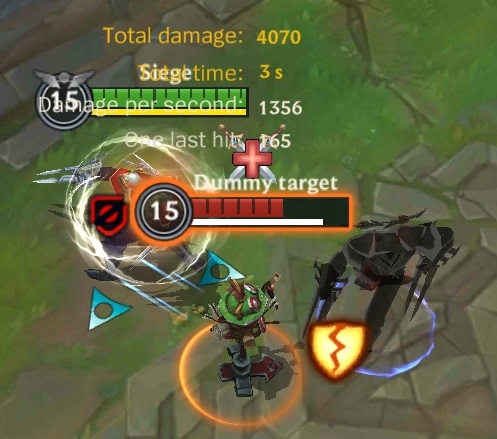
It dealt a total of 4,070. It is expected that on burst damage combos, Conqueror does worst. But I came up with an idea. The 4,070 value started without the Conqueror buff and ended with it. What if the combo starts with a full stack of Conqueror?
Third, with a full stack of Conqueror at the beginning of the combo:
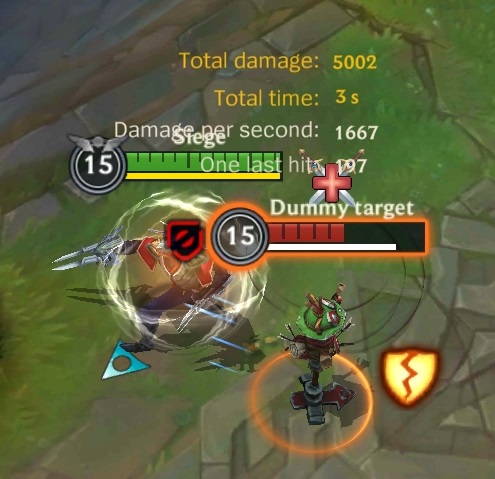
It dealt a whopping 5,002. If a Zed player can skillfully stack his Conqueror first before applying his combo, he can potentially kill even the toughest champion of the enemy team.
This goes to reinforce our first finding that Conqueror outperforms Electrocute once its fully stacked. Although, 5 stacks are a strict restriction which is tough to proc consistently on burst damage champions.
In the end, I believe that they are balanced and it boils down to these three rules of thumb:
- Electrocute is for burst damage champions.
- Conqueror is for DPS type champions.
- The above two rules can be broken depending on the playstyle of the summoner/player.
Aery

Aery is the Keystone Rune for Enchanter Support because it deals extra damage to their attack or abilities and provides an extra amount of shielding to healing or shielding abilities. Aery lingers on the damaged or shielded target and it can return faster by going near the target. Aery cannot be sent out again before it goes back to its owner.
Aery is sometimes used by non-Enchanter Support Champions like Malphite because it provides strong consistent damage bonus to his Q(1), Seismic Shard. By the same virtue, Aery is theoretically better for Artillery mages because they deal consistent damage long range and Aery will consistently add bonus damage unlike when using Electrocute which will grant a damage spike only once which is contradictory to an Artillery mage’s MO.
I did a comparison using Seraphine who is both an Enchanter support and an Artillery mage. In all versions of the test, I used her Q, E, Ult, and an auto attack to proc her passive once. No ability was echoed.

Electrocute deals a little more damage but I think it is not enough extra damage to choose it over Aery because poke type champions deal damage over time which makes Aery’s short “cooldown” better for them.
Pros
- No “cooldown”, Aery can immediately be used again once it returns.
- Aery is a balance of both offensive and defensive effects.
Cons
- Lower bonus damage compared to Electrocute and Conqueror
Example of Champions that uses Aery:
- Orianna
- Seraphine
- Sona
- Nami
- Janna
- Lux
Grasp of the Undying

Grasp of the Undying is a hybrid Rune which grants both offensive and defensive effects. Every four seconds in combat, your next attack heals you, permanently increase your HP, and deals a portion of your max health as magic damage to your target.
I think Grasp of the Undying is great for champions with built-in sustain like Garen and Dr. Mundo because you need to stay in fight for four seconds to activate the effect. You’ll want to activate the effect repeatedly to stack the max HP bonus.
Pros
- Balanced between offensive and defensive effects which scales with maximum health.
- Unlike Aery, Grasp’s offensive and defensive effects activate at the same time.
- Increases maximum health.
Cons
- Requires you to stay in combat for four seconds to activate the effect.
- Less bonus damage compared to Conqueror and Electrocute.
Example of champions who uses Grasp of the Undying:
- Garen
- Dr. Mundo
- Camille
- Nasus
- Fiora
- Gragas
Fleet Footwork

Fleet Footwork is another hybrid rune. It grants healing and bonus movement speed on your next attack with maximum Energy stacks which are acquired through moving, attacking, and casting abilities. The movement speed bonus is helpful for champions who wants the “kite” opponents. Kite or kiting is the term used to attack opponents from a distance while preventing them from fighting back by maintaining distance and constantly dodging.
Range champions uses Fleet Footwork to increase their kiting ability thanks to the bonus movement speed. Some melee champions can also use Fleet Footwork so that they can counter or keep up with kiting opponents and some high mobility champions like Tryndamere and Yasuo can also use this Rune to further increase their mobility and add to their survivability as well.
Pros
- Consistent healing mechanism which scales with damage.
- Bonus movement speed.
Cons
- No bonus damage.
Example of Champions that uses Fleet Footwork:
- Jhin
- Miss Fortune
- Vayne
- Dr. Mundo
- Nasus
Grasp of the Undying Vs. Fleet Footwork
Both of these Keystone Runes have healing effects so I compared them using Dr. Mundo, a champion who can use them both with equal effectiveness (This is subject to opinion and scenarios, I know).

Fleet Footwork consistently outheals Grasp of the Undying, albeit for only a small amount.
In the end, in my opinion, the amount of healing is not large enough to overpower these two other factors:
- If there are no high mobility champions in the enemy team, Grasp of the Undying is the better option because it increases your HP while decreasing the enemy’s HP at the same time. For example: A 112 heal and 112 damage will result in a 224 HP difference in a single proc of Grasp of the Undying.
- If there are high mobility champions in the enemy team, choose Fleet Footwork because the bonus damage means nothing if you cannot reach them. Fleet Footwork is generally better in hard matchups because you can activate it on minions for a lesser extent or just kite a single hit on the opponent for the better heal. You are not forced to engage just to activate the rune.
Aftershock

Aftershock is the rune for initiators. Upon using a crowd control on an enemy, you will be fortified with a significant amount of bonus armor and magic resistance. The additional resistances will allow you to survive dives and initiations. After a short while, you will deal a burst of magic damage based on your max health in the area around you.
Pros
- Increases survivability for initiators. Enemies will often, through reflex, target you if you dive the enemy lines. Aftershock will allow you to tank more damage.
- Adds a little more AoE damage to your initation.
Cons
- Its condition to immobilize enemy champions restrict its use for certain champions only.
Example of champions that uses Aftershock:
- Alistar
- Malphite
- Blitzcrank
- Amumu
Font of Life

Font of Life has changed this Patch 2.3, it applies a mark to a single target champion on damaging them. Once you or your ally attacks the target, the one who activated the mark and you are healed.
Font of Life is now easier to proc since you only have to damage the enemy to mark enemies. The downside to this is that it now has a fixed cooldown so you can only mark one enemy every time it is available unlike before where you have can mark enemies as long as you can impair their movement.
Before, it was choosing between the support’s own survivability by choosing Aftershock Vs. granting more sustain for allies through Font of Life. But now, the conditions for choosing between the two have also changed because of this adjustment as Font of Life. Now, Aftershock is clearly better when fighting against burst damage because of the bonus AR and MR for a short duration, and Font of Life is better on sustained fights because of the healing.
Another big change here is that it is now not reliant on attack speed. Before, high attack speed ADCs benefits the most from Font of Life but now, everyone can equally enjoy its effects.
Pros
- A great amount of free, scaling sustain for your whole team.
- A reliable source of sustain for drawn-out fights.
Cons
- Weak compared to Aftershock against burst damage.
- Can be countered by Grievous Wounds.
Example of champions that uses Font of Lfe:
- Nami
- Braum
- Janna
Phase Rush

Phase Rush is the newest Keystone rune to enter Wild Rift through Patch 2.3. It replaces Kleptomania that did not have a clear use and reliance on luck on fights are just well, unreliable. And therefore, it has a low pick rate. With the addition of Phase Rush, it is hoped to create a new dimension in Wild Rift’s ever-changing meta.
Phase Rush activates the same way as Electrocute. You have to hit a champion with three separate unique attacks or abilities in four seconds to activate its effects. Once activated, your champion will enjoy a huge burst of movement speed and grants a substantial amount of slow resistance.
“Why would I use this rune? This offers no damage whatsoever!” Yes, compared to Electrocute and Conqueror, it offers no bonus damage. But, what is the use of damage if you can’t even reach your enemies? This is the beauty of Phase Rush. It offers a huge amount of outplay potential for both offense and defense because of the massive movement speed bonus.
Here are some examples of Phase Rush’s usage
- You can use it on champions with high mobility like Graves and Vayne to add even more mobility so you can remain untouchable while kiting down opponents.
- Are you an immobile Juggernaut champion user like Darius and Nasus and you are just tired of enemies getting away from your high damage? Phase Rush will allow you to run down enemies without giving them any chance to escape.
- There are special interactions with certain abilities and Phase Rush that is simply surprising when pulled off. A popular example of this is Katarina’s ultimate, Death Lotus. When Death Lotus is activated during Phase Rush, it makes it almost impossible to get away from the burst damage. Kennen, Galio, and Wukong have abilities with similar interactions with Phase Rush.
Pros
- The enormous movement speed bonus opens up a lot of new possible outplay opportunities.
- Does not only offer offensive opportunities, but it also makes your champion harder to chase and kill.
Cons
- Lacking in damage compared to other offensive Keystone runes.
Example of champions that uses Phase Rush:
- Graves
- Aurelion Sol
- Darius
- Nasus
- Katarina
- Kennen
- Galio
- Jax
- Yasuo
Domination Runes
Domination runes are there to help you well, dominate, your games. These set of runes are there to specifically help you deal more damage, one way or another.
Brutal

Brutal is the most straightforward among Domination runes. It simply adds AD or AP and penetration depending on the type of damage you deal.
For the most part, you can just choose Brutal on almost all champions without any loss of efficiency. It’s bonus AD or AP, what’s not to like? If you are not sure what Domination rune you should use, just pick Brutal.
Brutal is best used on champions who like to play aggressively in the early game, assassins who can benefit from penetration a lot and for junglers since the bonus AD/AP and penetration will help clear the jungle camps faster.
Gathering Storm

Gathering Storm is an increasing AD or AP bonus. This Rune is best for champions who really pop off in the late game. It can also be used by tank and support champions who has great AD or AP ratios but are built with tank or support items.
| Minutes | AD | AP |
| 3 | 2 | 4 |
| 6 | 5 | 10 |
| 9 | 9 | 18 |
| 12 | 14 | 28 |
| 15 | 20 | 40 |
| 18 | 27 | 54 |
| 21 | 35 | 70 |
| 24 | 44 | 88 |
| 27 | 54 | 108 |
| 30 | 65 | 130 |
Gathering Storm starts giving out useful values at 9 minutes and it gives crazy bonus at 21 minutes onwards. At 21 minutes, it is like having a Black Cleaver or a Void Staff. On AP users, it is crazy good with Rabadon’s Overkill passive which amplifies the AP value of the user.
But of course, the downside is that it is weaker than any other Domination runes for the first 8 minutes.
Example of champions that uses Gathering Storm:
- Jinx
- Jax
- Kai’Sa
- Garen
- Gragas
- Corki
- Ziggs
Hunter – Vampirism

Hunter – Vampirism is great for champions with high scaling DPS champions who love extended fights. It is also best for champions played in the mid lane and jungle since they are the ones who have access to the map and therefore, they can stack it faster.
| Stacks | Vamp | AD | AP |
| 0 | 2% | 0 | 0 |
| 1 | 3% | 2 | 4 |
| 2 | 4% | 4 | 8 |
| 3 | 5% | 6 | 12 |
| 4 | 6% | 8 | 16 |
| 5 | 7% | 10 | 20 |
The AD/AP bonus at max stack is almost the same as Gathering Storm’s bonuses at 9 minutes. The difference is the way they are stacked. Yes, Hunter – Vampirism is more situational but it also grants the bonus Vamp.
With Gluttonous Greaves and Bloodthirster, you can potentially have 30% Vamp. The great thing about this combination is that it can be Overhealed into a shield. Be warned though, this strategy is like a pyramid of cards to Grievous Wounds.
Example of champions that uses Hunter – Vampirism:
- Riven
- Renekton
- Olaf
Triumph

Triumph is a fairly popular choice on assassins and bruisers. Its great on extended fights because of its bonus damage on low health enemies. How much is the bonus damage, really?
| Base Damage | Triumph amp (3%) | Infinity Orb amp (20%) | Combined (23%) |
| 100 | 3 | 20 | 23 |
| 200 | 6 | 40 | 46 |
| 500 | 15 | 100 | 115 |
| 700 | 21 | 160 | 181 |
| 1000 | 30 | 200 | 230 |
The bonus damage from Triumph itself is not that impressive in itself but it pays for itself in the long run. It is great for rushing down multiple resets on cleaning up. This is why it is popular on team fight assassins like Katarina and Akali.
Take note that the healing on takedown is on missing health. So, it can feel fairly underwhelming at times. Even so, it can be life-saving in tower dives.
Example of champions that uses Triumph:
- Katarina
- Akali
- Diana
- Garen
- Pantheon
Weakness

Weakness is the Domination rune choice for most supports because it is the only Domination rune that can amplify the damage of the whole team. Weakness activates when an enemy champion is impaired by its wielder. Impairing the movement of enemy champion means a wide range of crowd controls. Slows, stun, charms, knockups all activates Weakness.
Ashe is one of the best wielder of Weakness because she constantly slows down enemies with her basic attacks. She is a viable Weakness user even if she does is played as the ADC.
Example of champions that uses Triumph:
- Ashe
- Galio
- Lulu
- Nami
- Janna
Champion

Champion can be the most broken rune or the most useless. It grants a huge damage bonus against champions but you 4% of it each time you die. It is great for early game champions who can press their lead and force the issue in the early game without much risk of dying themselves.
Example of champions that uses Champion:
- Lee Sin
- Renekton
- Fizz
- Pantheon
- Fiora
Resolve Runes
Resolve Runes are your defense stat boost. It gives a little bit of something that will help you survive your fights, or a certain type of attack from your enemies. Unlike the other runes, Resolve rune are not only chosen based on your playstyle, you also have to consider the type of damage your enemies can dish out.
Adaptive Carapace

Adaptive Carapace replaces Spirit Walker in Patch 2.3 because some players are simply picking the latter for the 50 bonus HP and the slow resistance becomes just a happy bonus. Now, Adaptive Carapace grants bonus adaptive resistance once the champion’s HP dips below 50% health.
The champion gains either 12 armor or 12 magic resist depending on what type of damage they took more in the past minute. If the champion took more physical damage, they will gain 12 armor. If they took more magic damage, they will gain 12 magic resist.
This rune is great for champions who like to dish it out on extended fights, especially those who specifically get stronger the more hits they dish out or the lower their health becomes.
Example of champions that uses Adaptive Carapace:
- Dr. Mundo
- Darius
- Olaf
- Jax
- Tryndamere
Conditioning

Conditioning received a buff this Patch 2.3. Instead of simply gaining bonus armor and magic resist after 5 minutes, additional armor and magic resist bonus are given out every two minutes after the first bonus at 5 minutes.
| Minutes | AR/MR |
| 5 | 8 |
| 7 | 10 |
| 9 | 12 |
| 11 | 14 |
| 13 | 16 |
| 15 | 18 |
| 17 | 20 |
| 19 | 22 |
| 21 | 24 |
| 23 | 26 |
Conditioning is great for champions who have enough survivability in the early game and wants to get even tankier in the late game. It is also perfect for champions who have abilities that scale with their armor – Rammus or magic resist – Galio.
Another factor to consider here is that the Aftershock Keystone Rune directly benefits from this Resolve Rune because its bonus armor and magic resist bonus directly scales from your said stats.
Remember that Conditioning does not give anything for the first five minutes so keep in mind that this is a relatively high risk Resolve Rune that should only be taken if you are confident that you won’t have a hard time for the first 5 seconds.
Hunter – Titan

Hunter – Titan is one of the, if not the most, popular Resolve rune. It is because it counters one of the strongest mechanics in all of MOBA, crowd control. It grants 4% tenacity and 20 max health for each takedown for a total of 20% tenacity and 100 max health.
| Stacks | Bonus HP | Bonus Tenacity | With Mercury’s Treads (35%) |
| 1 | 20 | 4% | 37.6% |
| 2 | 40 | 8% | 40.2% |
| 3 | 60 | 12% | 42.8% |
| 4 | 80 | 16% | 45.4% |
| 5 | 100 | 20% | 48% |
Tenacity is the term in League for crowd control resistance. It reduces the duration of almost all forms of crowd control like stuns, slow, charm, blind, roots, and taunt. Curiously, it does not reduce the duration of knock-ups so keep that in mind when trying to decide what Resolve rune you are going to use. Yes, it cannot counter the Malphite + Yasuo knock-up combo that makes you airborne for a gazillion years.
The numbers may not seem to make sense at first because it stacks as a diminishing return. Instead of 20% + 35% = 55%, it is computed as 1 – (1-35%) * (1-20%) = 48%. Still, 48% is a significant amount. A 2 second stun will now only last for 1.04 seconds.
Hunter – Titan is usually taken on fighters and assassins who have to be up close and personal. If the enemy team has two or more crowd control champions, being controlled is a dangerous situation to be in. This rune and in combination with Mercury’s Treads will counter their disables by almost half its duration which buys you more time to survive your enemies and launch your counterattack.
Second Wind

Second Wind passively grants 6 health regen every 5 seconds. After taking damage from an enemy champion, it grants another bonus regeneration based on your missing health. It is the best Resolve rune against those pesky poke type champion who has nothing better to do than deal small but consistent long range skill shots.
| Lost HP | Default Bonus Regen (/5 secs) | Additional Regen (/10 sec) | Total (/10 sec) | Total (/sec) | Melee (/sec) |
| 100 | 5 | 9 | 19 | 1.9 | 3.8 |
| 200 | 5 | 12 | 22 | 2.2 | 4.4 |
| 500 | 5 | 21 | 31 | 3.1 | 6.2 |
| 1000 | 5 | 36 | 46 | 4.6 | 9.2 |
| 2000 | 5 | 66 | 76 | 7.6 | 15.2 |
The numbers may not seem much but the key factor here is that it does not have a cooldown. In my opinion, the numbers are just right and anything more may outright take poke type champions out of the meta.
It may not nullify Teemo or Kennen’s harass 100% (it shouldn’t) but Second Wind will definitely make it more bearable to play against them.
Loyalty

Loyalty is pretty much a straightforward rune. It grants a little armor and magic resist to you and to the allied champion closest to you. It is arguably the worst Resolve rune out there but it gives a little stat to your ally so its not too bad, right?
The answer to that is very subjective. But if you are a melee support, almost any other rune is simply better. For an enchanter support, Loyalty might be a good choice, since you are not supposed to get hit anyway.
Bone Plating

Bone Plating is the last Resolve Rune to be added this Patch 2.3. It is the most situational among all the Resolve rune because it is custom tailor-made to be used against burst damage, combo dishing champions. It lasts for only 1.5s and it has a long cooldown of 45 seconds.
To block a total of 90 to 180 damage is no joke. But it can be easily countered by pokes and by being attentive. If you are an assassin, take note of the champions who have recently taken damage. You can see the green plates around the champion when it is activated. You can narrow down your search by only looking at your preferred targets which are usually the mid laner, support, and ADC.
If you are a laner, just like when noting when the enemy’s Flash is on cooldown, you can tell your teammates on chat that the enemy’s bone plating is activated and so the jungler or your mid laner can now attempt a gank.
Examples of champions who you make use of Bone Plating when against them:
- Zed
- Kha’Zix
- Rengar
- Katarina
- Diana
- Fizz
Inspiration Runes
Inspiration Runes are utility runes that focuses on adding another dimension of advantage to your gameplay through gold generation, objective control, movement speed bonuses, more ability haste, or more mana.
Pathfinder

Pathfinder is the ultimate rune for ganking junglers. The 8% bonus movement speed is no joke. It’s equivalent to equipping a Momentum item like Youmuu’s Ghostblade or Dead Man’s Plate.
If you are planning to relentlessly gank around the game from the get-go. This rune is a must-have for you.
Example of champions that uses Pathfinder:
- Lee Sin
- Rammus
- Rengar
- Vi
- Jarvan
Mastermind

If you are a jungler and you are not taking Pathfinder, you must be taking Mastermind instead. The 10% bonus true damage to epic monsters makes it easier to secure the drakes with your damage combo + Smite. This is especially true for Evelynn where her ultimate, Last Caress + Smite is impossible to outsmite. There is also a 10% bonus adaptive damge on turrets so you’ll also be a potent splitpusher. Baron laners sometimes take this rune to amplify their splitpushing power.
The bonus 120 gold upon taking or assisting in taking these objectives is the sweet bonus on top. This gold bonus is snowball gold. This means that it will help you push your lead further while you are taking one objective after another.
| Objective taken | Ideal Time Stamp | Total Bonus Gold |
| 1st Drake | 4 Minutes | 120 |
| 1st Tower | 5 Minutes | 240 |
| Rift Herald | 6 Minutes | 360 |
| 2nd Tower | 7 Minutes | 480 |
| 2nd Drake | 8 Minutes | 600 |
| 3rd Tower | 9 Minutes | 720 |
| 4th Tower | 11 Minutes | 840 |
| 3rd Drake | 12 Minutes | 960 |
This might look like a lot of bonus gold but it is unreliable because of two things: First, you have to be secure the objective, every game won’t be like this unless you are snowballing. Second, you have to be present at the objective and dealt damage in order to gain the bonus gold.
Hunter – Genius

Hunter – Genius is the only rune in the game that grants ability haste. For champions who rely on ability haste, this is an invaluable tool.
| Stacks | Ability Haste | Cooldown Reduction |
| 0 | 2.5 | ~2.5% |
| 1 | 5 | ~5% |
| 2 | 7.5 | ~7% |
| 3 | 10 | ~9% |
| 4 | 12.5 | ~11% |
| 5 | 15 | ~13% |
| W/ Ionian Boots of Lucidity | 30 | ~23% |
| W/ Trinity Force + CD Boots | 55 | ~35% |
With two ability haste items, you will have substantial cooldown reduction. With Hunter – Genius, you won’t have to bend over backwards with your itemization just to have the ideal amount of cooldown reduction that you need.
Sweet Tooth

Sweet Tooth is the most popular Inspiration rune for laners and for a good reason. The increased Honeyfruit healing is a big help in the laning phase and the bonus gold is a great help on reaching item timings.
For example, with perfect last hits and Sweet Tooth gold, you will be able to recall @ 3:40 with enough gold for a first item costing around 3,000 gold. Recalling at 3:40 will allow you to set up camp at the Dragon Pit before it spawns. Without the Sweet Tooth rune, you will need an extra wave and you will still be at base when the drake spawns, making you late for the first dragon fight.
| Honeyfruits Eaten | Timestamp | Total Gold Gained |
| 3 | 0:45 | 60 |
| 6 | 2:45 | 120 |
| 9 | 4:45 | 180 |
| 12 | 6:45 | 240 |
| 15 | 8:45 | 300 |
| 18 | 10:45 | 360 |
| 21 | 12:45 | 420 |
| 24 | 14:45 | 480 |
| 27 | 16:45 | 540 |
| 30 | 18:45 | 600 |
You should not eat the Honeyfruit simply for the gold because the health and mana regen it provides is a big deal in the laning phase. So, the timestamp given here is not one you should strictly follow, you might be able to eat more Honeyfruits by eating the ones at the river and at the enemy’s side once you have destroyed their turret.
A little tip on Honeyfruits is that its regeneration is based on your missing health so do not eat it immediately if you are still relatively high on health unless there is a threat of being combo’d do death if you are not full health. As of Patch 2.3, if someone else eats the Honeyfruit and you are around and you have Sweet Tooth, you will still gain bonus gold. So be nice and share your fruits.
Pack Hunter

Pack Hunter is a great Inspiration rune for tank supports because the bonus movement speed does not go away when in combat unlike in Pathfinder. The little bonus gold might make the difference on a game-changing initiation.
The bonus gold is nice, but you can give it just once per teammate.
Manaflow Band

Manaflow Band is the Inspiration rune for mana-hungry mages and enchanter supports. It is also great for Tear of the Goddess users because it upgrades into items that grant bonuses based on maximum mana.
| Item | Effect | Bonus from Manaflow Band |
| Muramana | Awe – 1.5% of max mana into bonus AD | 4.5 AD |
| Shock – 3% of current mana into bonus damage x2 | 18 damage (decreasing) | |
| Seraph’s Embrace | Awe – 3% of max mana into bonus AP | 9 AP |
| Lifeline – 15% of current mana into a shield | 45 shield | |
| Fimbulwinter | Awe – 1% of max mana into bonus ability haste | 3 AH |
| Frozen Colossus – 5% of max mana per nearby enemy champion | 15 – 75 shield |
It may not seem much but Manaflow Band is the only inspiration rune that can have an impact on your AD and AP values. Tear of the Goddess items are all about scaling and this rune will help you to scale even harder.
Conclusion
Runes have their unique effects and, champions have different playstyles depending on the Runes you choose and the items you build. You can also check out our champion guides or the top builds in game so you’ll have an idea of the best Runes and builds played in the current meta.
In the end, your performance will be determined by the time and practice you spend in game. And remember, winning is nice and good but, having fun is what matters the most! Thank you for reading and good luck on your games, summoner!

A very good guide but there are new runes in the game, think someone should add them